The Digital Future of Exhaust Gas Temperature Sensors
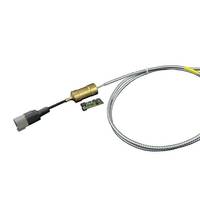
CMR Group’s chief technical officer, Patrice Flot, considers the current approach to sensing exhaust gas temperature (EGT) on high horsepower engine platforms and the capabilities provided by new digital technology. An EGT sensor measures the temperature of the engine exhaust gas to prevent damage to critical components such as the after treatment system, turbines and cylinder head exhaust valves. It can also be used inside the combustion chambers where hot gases are generated.
Another Scrubber Retrofit for Vulica Shipping
DuPont awarded third marine scrubber order by Vulica Shipping Co. Ltd. Vulica Shipping Co. Ltd. has selected DuPont Clean Technologies for the supply of a hybrid single-stream scrubber designed by DuPont subsidiary Belco Technologies Corporation (BELCO) to be retrofitted to MV H.A. Sklenar, a self-unloading bulk carrier that operates along the Gulf of Mexico. The vessel is owned by Vulica Shipping Company Ltd., a subsidiary of Vulcan Materials. “We designed the exhaust gas scrubber tower and scrubber system so Vulica could efficiently treat the exhaust gas produced by the main diesel engine on MV H.A. Sklenar,” Garrett Billemeyer, Technology Development manager explained.
MAN Diesel and Turbo to Power Giant Crane Vessel
MAN Diesel & Turbo has signed a contract with Sembcorp Marine in Singapore to supply the dual-fuel propulsion system – including exhaust-gas after-treatment – for a New Semi-submersible Crane Vessel (NSCV) for Heerema Offshore Services. The scope of the contract – signed on 30 October, 2015 – provides for 12 × MAN 8L51/60DF four-stroke engines + 12 × MAN SCR (Selective Catalytic Reduction) systems. MAN Diesel & Turbo states that the total power output of the engines is some 96 MW and believes it – with the exception of power barges – to be one of the largest engine installations the world has ever seen aboard a single ship. Certainly, it is the first vessel of this size to feature dualfuel technology and, upon completion, will be the largest vessel of its kind globally.
SCR Systems Chosen for Newbuild Trawlers
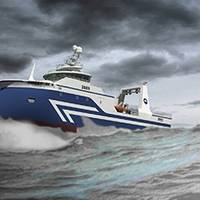
Three wetfish trawlers being built for Icelandic fishing company HB Grandi will feature MAN SCR Selective Catalytic Reduction (SCR) system in addition to MAN main engines. MAN Diesel & Turbo states that the system will enable the trawlers’ IMO Tier II-compliant engines to fulfill the IMO Tier III NOx emission requirements. Vilhjalmsson added that HB Grandi deliberately pursues a green company profile and that its focus on clean and responsible fishing ultimately led to MAN technology being chosen for the trawlers.
Turbocharger Modification
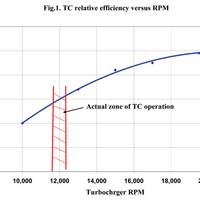
A turbocharger’s efficiency significantly influences diesel engine performance. • Exhaust gas temp. Operational turbocharger maximum efficiency is achieved by the accurate coordination of turbocharger and diesel cylinders characteristics during the design and the engine’s test-bed trial stage. Usually such coordination is performed by engine manufacturers for design point only (for MCR). But in the real world, marine turbocharged engines operate on loads less than MCR. Based on practical experience…
New Diesel Soot Filtration System
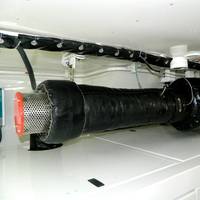
Problems caused by inefficient regeneration of a Diesel Particulate Filter (DPF) can be eliminated with the installation of a SeaClean Soot Filtration System (shown above) by marine exhaust system engineering, design, fabrication and service company DeAngelo Marine Exhaust. The SeaClean system monitors the exhaust gas temperature and varies the power going to the heater element so that exhaust gas temperatures are constant. This allows a DPF to work properly so that collected soot is burnt off at high temperature, leaving only a tiny ash residue.
MAN Diesel & Turbo and the Tier-III Age
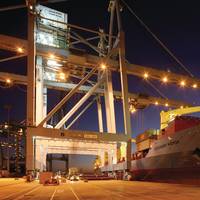
The introduction of the electronically controlled camshaft-less low speed diesel engines (ME-range) are a milestone in diesel technology, a milestone that deserves a place in history similar to Rudolf Diesel’s first engine in Augsburg for the 1912 motor vessel Selandia, the introduction of turbocharging on two-stroke diesels in 1954, and the first SCR (Selective Catalytic NOx Reduction) systems on ships in 1989. The IMO Tier III NOx regulations that will come into force in 2016…
ABB Increase Promotion of Valve Control Management
ABB Turbocharging said it will step up its promotion of variable valve train system, Valve Control Management (VCM). VCM helps a turbocharger to manage air actively so that an engine can operate at different speeds, loads and ambient conditions, thereby increasing its range of application and operation. A major market for this technology is gas power plants. VCM offers new options for higher performance engines that need either a wide range of operation or a fast load response, such as on tugboats, off-highway trucks and emergency power generators. Suboptimal air-fuel flow results in greater risk of engine knock, more polluted exhaust and lower efficiency.
Northern Lights to Show DECS at Miami Boatshow
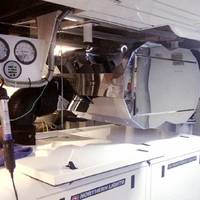
Northern Lights to feature its Diesel Exhaust Cleaning System (DECS) at the 2013 Progressive® Insurance Miami International Boat Show. Based on DCL International’s MARINE-X™ system, DECS removes soot and particulate matter as it is emitted from the diesel engine. The air and water quality on and around the vessel is vastly improved, offering a clean, enjoyable environment for everyone on board. When equipped with DECS, exhaust gas is routed through a catalytically coated ceramic filter, trapping soot and particulates.
Exhaust Gas Cleaner Introduced by Northern Lights
Northern Lights provides soot & particulate matter removal solution for diesel engine exhausts with DECS. DECS, or Diesel Exhaust Cleaning System, is based on DCL International’s MARINE-X™ system which removes particulates as they are emitted from the engine. Air and water quality in and around the vessel are thereby vastly improved. When equipped with DECS, exhaust gas is routed through a catalytically coated ceramic filter. Soot is trapped and the filter is kept free of restrictions. DECS uses a passive regeneration process. Unlike competitors’ active systems which require additional equipment and regeneration time, with DECS, the Northern Lights generator set functions as normal while particulate matter is continually burned off using the heat emitted by the engine’s own exhaust.
First Tier-III-Compliant, Two-Stroke Engine Unveiled in Japan

The engine, an MAN B&W 6S46MC-C8 type capable of an output of almost 7 MW, was constructed in autumn 2010 by Hitachi Zosen Corporation at its Ariake works in southern Japan. The engine is bound for a general cargo carrier, to be built at the Nakai shipyard and scheduled to enter active service later this year. The vessel was ordered by Japanese customer, BOT Lease Co. Ltd., and is operated by Nissho Shipping Co. Ltd. The first engine-start took place in January 2011. In connection with this…
Norwegian Manufacturers Maintain Edge
The cliche “the more things change, the more they stay the same,” certainly applies to the past, current and future role of the Norwegian maritime cluster in the grand scheme of the international ship and boat building communities. Few countries, if any, can boast the maritime history of Norway, a history that entails many colorful tales surpassed only by the number and magnitude of marine innovations, which have emerged from a country with a population (approx. five million), which is smaller than many large cities. And while corporate consolidations around the globe continue to morph the marine market — including many notable Norwegian companies such as Ulstein…
Wärtsilä Releases New Medium-Speed Standard for the Future
The Wärtsilä 46F is the latest in the highly successful marine engine series launched in 1987 with the Vasa 46, as it was then called. Though visually similar to the original Wärtsilä 46, with similar bore and stroke, the Wärtsilä 46F is a new engine with the latest technology applied to all major components. It is packed with new features including common rail injection and scaleable embedded control, for high performance and record-low exhaust emissions, regardless of fuel quality. It is ideally suited to applications which place a premium on optimum space layout, savings in operating and maintenance costs, superior environmental performance and fuel adaptability. The Wärtsilä 46F is our proud and most recent achievement in medium-speed marine engines.
Automated Combustion Analysis: Taking The Measure of Peak Performance
Monitoring diesel engine performance by traditional, manual methods is time-consuming and inherently imprecise. The limitations of those methods make it difficult to identify and pinpoint performance problems reliably. In addition, preventive maintenance routines adopted to compensate for lack of adequate data inevitably incur unnecessary costs-while the engine can still suffer from problems and imbalances that occur and remain undetected between scheduled overhauls. Ship owners and operators in fast-growing numbers are turning to automated combustion analysis to eliminate the costs of reliance on manual monitoring. In the span of a few minutes, an automated system can provide a complete, accurate picture of what is actually happening during the combustion process in each cylinder.




